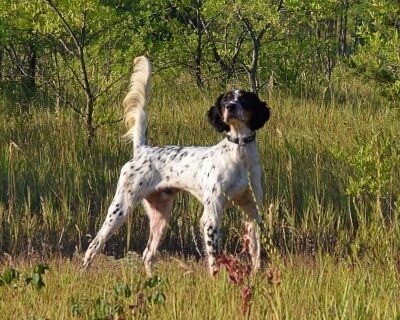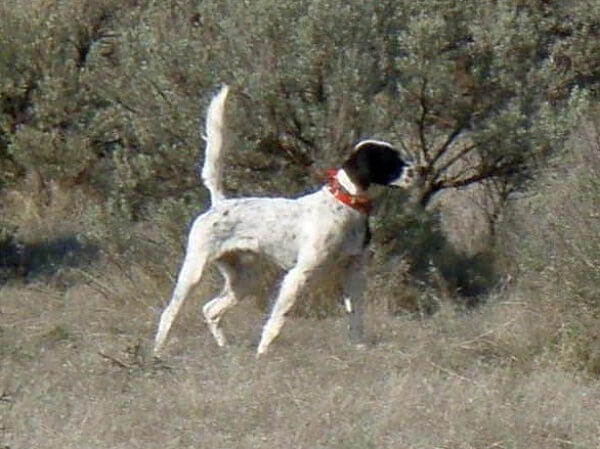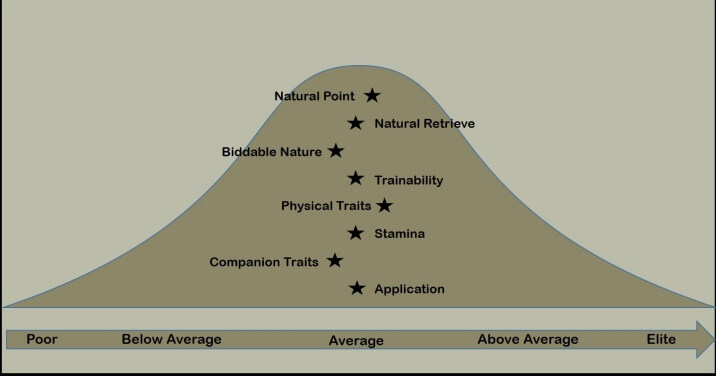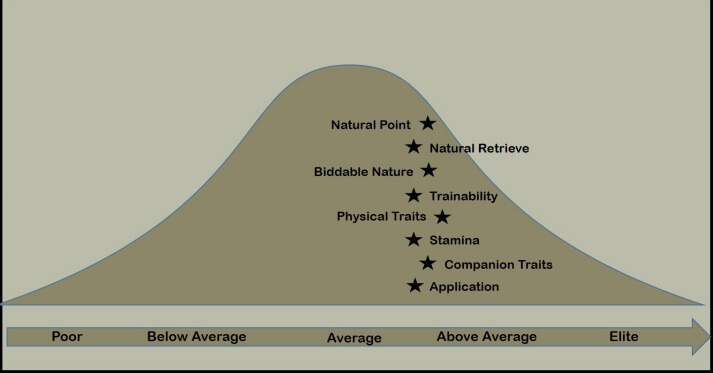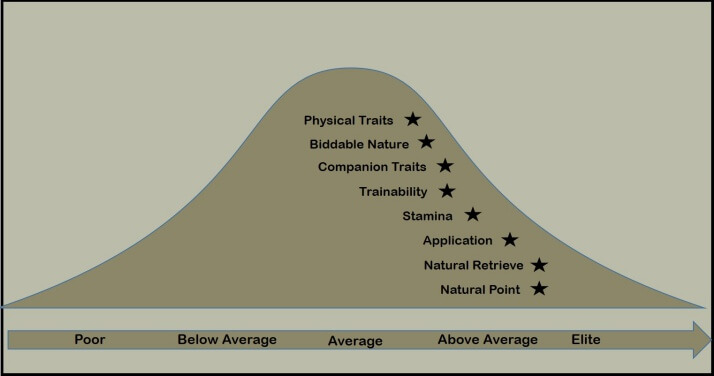English Setter Breeders
English Setter breeders apply different weight to specific traits. Additionally, terms and traits are defined inconsistently. Therefore, Identifying the best English Setter breeders or the best litter for you requires some insight we hope to provide in various articles on this site. We will continue to add articles on this topic over time.
“How to pick a pup” articles are also misleading because this approach puts the cart before the horse. The point here being that most important traits are simply not apparent at 8-10 weeks of age. For example, bird finding and bird handling can’t be evaluated at this age. Training and cooperation traits are also impossible to gauge at this age. Disposition and companionship are also traits that take months to develop. For all these reasons, puppy picky techniques should not be your focus. Picking a litter or breeder is the best approach to finding a great pup.
Litter Evaluation
Evaluating an English Setter litter or English Setter breeders are basically the same thing. The merit of any litter is a product of the relative merits (traits) of the parents. Therefore, the relative merit of a litter can be gauged by the practices used in selecting the sire and dam. The suitability of these individuals for breeding purposes can be thought of in terms of how they rank across all of the key traits that impact performance. As noted above, each English Setter breeder places a different degree of value on specific traits. Their preferences or opinions on how traits should be expressed also vary. My advice is to ask the breeder to explain their position on the traits that influence performance. This will improve your ability to evaluate a given litter and pick the best pup for your specific preferences.
Breeder Selection Traits
Bird handling is basically the percentage of birds handled properly given a reasonable opportunity. Obviously, the ability to get birds pointed as opposed to bumping them makes a huge difference in productivity. Therefore, producing elite pointing dogs starts with selecting individuals that handle game exceptionally well. This is especially true for species like ruffed grouse that are more difficult for a pointing dog to handle. Of course, there are training techniques that can be used to develop better bird handling ability. However, innate ability should be heavily weighted in the selection process.
Trainability or “biddability should always receive considerable weight. These traits have influence on the dog being a good companion. Of course, it also has a huge impact on developing a great hunting dog. This is sometimes evaluated in terms of intelligence. However, I prefer to evaluate this trait within a broader context of “mental make-up”. Intelligence, cooperation, and composure in aggregate determine just how easy a dog adapts to and accepts training. Intelligence does not insure cooperation. Mental make-up also has considerable influence on just how good the dogs will be as a companion.
If you highlight anything from the article it should be there are no perfect dogs. The goal for any English Setter breeder is to find individuals that rank high across all traits. Keep in mind only a small percentage of individuals rank above average to excellent across all traits. The problem is the only way to conclusively evaluate these traits would be to hunt over the parents of every litter that interests you. Of course, this is virtually impossible and one day is an inadequate sample size. What you can do is evaluate the breeding practices used to identify elite individuals.
Selection Practices
English Setter breeders will tend to value traits differently, they also apply different selection methods. Understanding what the breeder values and how they go about evaluating/selecting individuals is key to finding the right litter for you. Ask the breeder how they select breeding stock. How were they proven? Of course, proven is a relative term and breeders are quite prone to bias. Look for the most tangible forms of proof you can find. References are also helpful especially with a repeat mating or where the reference has a pup out of at least one of the parents. In addition, good breeders can articulate specifically how they go about evaluating prospective breeding pairs. You can also look for specifics that indicate any given process identifies great bird finding, bird handling, and mental make-up. Ask specific questions if it is unclear how the key traits are proven by the breeder’s practices.
Breeder Selection Ratios
The degree of selectivity is extremely important. Selectivity in this context simply means did the breeder evaluate 2 or 4 or 8+ females as opposed to simply keeping and breeding a given dog. Elite individuals are above average to elite across all performance traits. This occurs in a small percentage of the population. This is why consistently coming up with great females requires the rejection of good or even very good females. Females are being treated separately here because an outside stud can be used but the concept is the same.
Determining relative selectivity requires asking the breeder about dogs they have culled. More specifically, what ratio is culled and how they determine which are culled. Another option is to ask for references of people who bought the breeders culls (started dogs). English Setter Kennels that cut good or even very good dogs is a very good indication the breeding stock being retained is exceptional.
Don’t just ask for a reference. Any breeder can come up with a couple good references. Ask for a list of people that have bought started dogs in the past 5-10 years. The breeder need not offer contact information for every one of them. Just ask them to provide names. Then, pick 3-4 random names and call those people. This avoids the breeder picking a couple names they know are the most satisfied. The list itself can be used to verify the degree of selectivity employed by the breeder. Also, consider the selection ratio. If the breeder has 4 breeding females, I would hope the breeder can provide a list of 20-30 people with started females. Ten or less would indicate relatively indiscriminate breeding for a breeder with 4-5 females. You can also use the same random list method to get puppy references.
Stud Dog Selection
You should always ask English Setter breeders to articulate exactly why a given stud is the best selection for a given female. While selecting the stud did the breeder consider a number of elite individuals? In contrast, a breeder using the one male they to own is not a sign of careful stud selection. Another consideration is the track record of the sire. Keep in mind great dogs don’t necessarily produce great dogs. Some sires are considerably more consistent than others in terms of what they produce.
Also keep in mind that line bred dogs are likely to be more consistent in production that heterogeneous dogs. Ask what specific traits the line is known to produce. It’s also a good idea to assess how well the breeder know the ancestors. Finally, be sure to ask how the individual traits of the sire and dam match up. For example, breeding a dog that is bigger than ideal to a dog that is smaller than ideal is not a good way to get dogs of ideal size. All of these questions factor into the odds of a great result when picking a stud dog.
Summary
Selecting a pup is a decision you live with (probably literally) for 12-16 years. You are essentially adding a new member of your family. Don’t hesitate to ask questions. You are the one who will live with this decision. Don’t be reluctant to ask any English Setter breeder for references. This is a reasonable expectation even with a well known English Setter breeder. Hopefully the information and ideas here can make it just a little easier for you to find that ideal hunting dog and companion. Good luck!
The graphic above depicts an avergae individual for the breed plotted on a standard curve. Some traits are above average and some are below average.
The graphic above depicts the traits considered by most breeders plotted on a standard curve. All traits are rated above average and some traits are well above average. Therefore, such an individual is a better choice than the previous example but an ideal choice would be elite in some or several traits..
The graphic above depicts traits that are well above average and elite in several traits. This is not meant to depict the ideal individual but the concept depicted here is an individual with no weaknesses and several traits well above average to elite. Therefore, this individual is a good example of highly selective breeding.
Trait Descriptions
Definitions for traits vary. Listed below is a brief description for those traits without obvious definitions.
Biddable Nature refers to a dogs desire to please and generally cooperative nature.
Application refers to how intelligently the dog hunts objectives.
Physical traits refers to the relative merit of the dogs build and gait.
Companion traits are associated with the dogs disposition and ability to be calm of task.
